ASAP 2020 Plus operator manual
Version number:

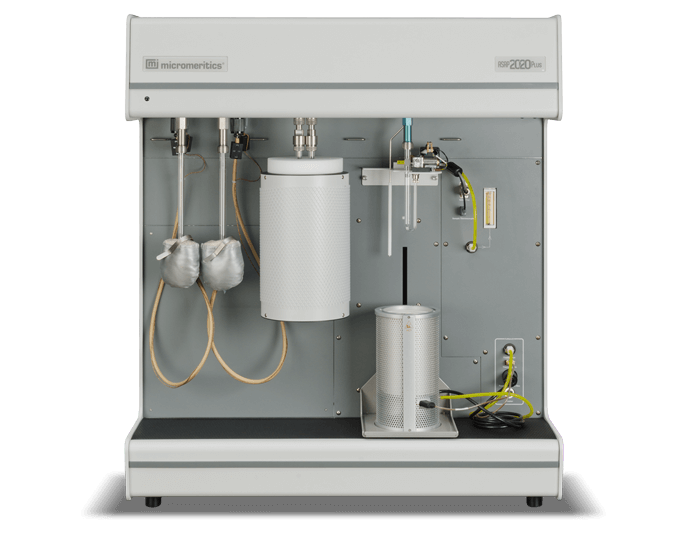




Looking for more information?
To request a quote, more information or download a brochure select an option below.
The Micromeritics ASAP 2020 Plus is a high-performance adsorption analyzer for measuring surface area, pore size, and pore volume of powders and porous materials. Standard methods or user-customized protocols can be used to characterize adsorbents, catalysts, zeolites, MOFs, APIs, excipients, and a wide variety of porous and non-porous materials.
The ASAP 2020 Plus is ideally suited for gas adsorption analysis of microporous (0.35 - 2 nm) and mesoporous (2 - 50 nm) materials and delivers superior accuracy, resolution and data reduction.
A vapor sorption option can be added to the ASAP 2020 Plus to extend the analysis range of the ASAP 2020 Plus physisorption.
A chemisorption option extends the application range of the ASAP 2020 Plus to both physical and chemical adsorption for characterizing the texture and active surface of catalysts, catalyst supports, sensors, and a variety of other materials.
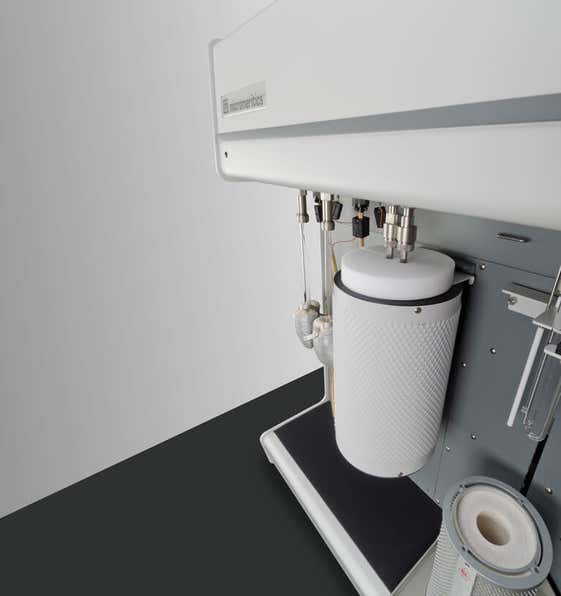
The programmable, two-station degas system allows physisorption sample preparation while running a chemisorption analysis
Twelve gas inlets allow multiple probe gases to be investigated maximizing efficiency and range of applications
Dedicated exhaust port for external detector connections
High-temperature 1100 °C furnace rapidly ramps to temperature and provides excellent, stable temperature and control with quick cool downs
In-situ chemisorption sample preparation and activation provides a fully automated method that does not require user intervention; the design permits quick and easy transition from chemisorption to physisorption analysis
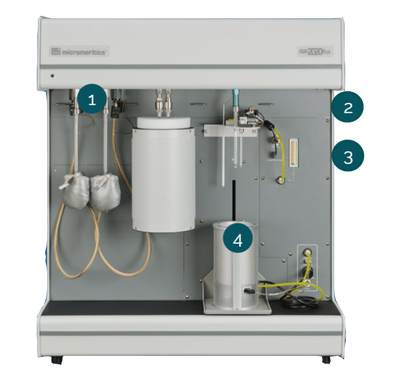
Programmable two-station degas system for automated SOP sample preparation
A dedicated P0 sensor allows for a faster analysis and provides P0 values at the same conditions as the adsorption measurement
Six analysis gas inlets with dedicated vapor and helium free-space ports provide greater flexibility and automated selection of pretreatment, backfill, and analysis gases
Proven Isothermal Jacket Cold Zone Control provides accurate, reproducible temperature maintenance
Long duration and refillable dewar provides virtually unlimited time of-analysis capability
Standard, independent dual vacuum systems (one for analysis, one for sample pretreatment)
Standard dry pump design eliminates the need for cold trap
Proprietary transducer system provides unequalled stability, fast response, and low hysteresis for improved accuracy and signal to noise improvement
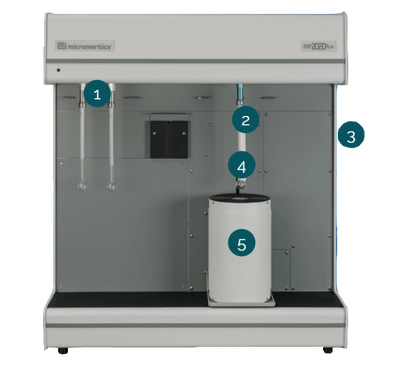
Knowledge of surface area, total pore volume, and pore size distribution is important for quality control of industrial adsorbents and in the development of separation processes. Surface area and porosity characteristics affect the selectivity of an adsorbent.
Surface area and porosity must be optimized within narrow ranges to accomplish gasoline vapor recovery in automobiles, solvent recovery in painting operations, or pollution controls in wastewater management.
The wear lifetime, traction, and performance of tires are related to the surface area of carbon blacks used in their production.
Fuel cell electrodes require high surface area with controlled porosity to produce optimum power density.
The active surface area and pore structure of catalysts influence production rates. Limiting the pore size allows only molecules of desired sizes to enter and exit, creating a selective catalyst that will produce primarily the desired product.
The surface area of a pigment or filler influences the gloss, texture, color, color saturation, brightness, solids content, and film adhesion properties. The porosity of a print media coating is important in offset printing where it affects blistering, ink receptivity, and ink holdout.
The burn rate of propellants is a function of surface area too high a rate can be dangerous; too low a rate can cause malfunction and inaccuracy.
Controlling the porosity of artificial bone allows it to imitate real bone that the body will accept and allow tissue to be grown around it.
By selecting high surface area material with carefully designed pore networks, manufacturers of super-capacitors can minimize the use of costly raw materials while providing more exposed surface area for storage of charge.
Surface area is often used by cosmetic manufacturers as a predictor of particle size when agglomeration tendencies of the fine powders make analysis with a particle-sizing instrument difficult.
Surface area and porosity of heat shields and insulating materials affect weight and function.
Porosity is important in groundwater hydrology and petroleum exploration because it relates to the quantity of fluid that a structure can contain as well as how much effort will be required to extract it.
Nanotube surface area and microporosity are used to predict the capacity of a material to store hydrogen.
Surface area and porosity play major roles in the purification, processing, blending, tableting, and packaging of pharmaceutical products as well as their useful shelf life, dissolution rate, and bioavailability.
Surface area and porosity affect the curing and bonding of greenware and influence strength, texture, appearance, and density of finished goods. The surface area of glazes and glass frits affects shrinkage, crazing, and crawling.
| Analysis range | 1.3 x 10-9 to 1.0 P/P0 |
|---|---|
| Roughing pump | 4-stage diaphragm |
| Min. measurable surface area | Standard: 0.01 m2/g 0.01 m2/g
Krypton: 0.0005 m2/g 0.0005 m2/g |
| Adsorptive gas inlets | 6 |
| Vapor sorption | Included, optional heated vapor source |
| Degas | 2 |
| Pressure transducer system | 1000 torr 0.12% reading |
| Transducer accuracy | 10 torr 0.12% reading
0.1 torr 0.15% reading |
| Dewar | 3.2 L, unlimited holding time with refill during analysis |
| Cryogen free space control | Isothermal Jacket |
| Data Analysis | BET Surface Area, t-Plot, BJH, Horvath-Kawazoe, Saito-Foley, Cheng-Yang, DFT, NLFT, and others |
| Advanced modeling | Heat of Adsorption, GAB, Sips, Toth, dissociative Langmuir, Redlich-Peterson, Virial Equation, AutoFit BET |
| Instrument operation dashboard | Dashboard permits real-time monitoring of critical parameters |
| Analysis range | 1 x 10-6 to 900 torr |
|---|---|
| Roughing pump | 4-stage diaphragm |
| Adsorptive gas inlets | 12 standard; optional up to 16 |
| Vapor sorption | Included, optional heated vapor source |
| Furnace | Ambient to 1100 °C
Programmable from 0.1 to 50 °C/min |
| Degas | 2 |
| Pressure transducer system | 1000 torr 0.12% reading |
| Transducer accuracy | 10 torr 0.12% reading
0.1 torr 0.15% reading |
| Dewar | 3.2 L, unlimited holding time with refill during analysis |
| Cryogen free space control | Isothermal Jacket |
| Data Analysis | Metal dispersion, Metal surface area, Crystallite Size |
| Advanced modeling | Heat of Adsorption, GAB, Sips, Toth, dissociative Langmuir, Redlich-Peterson, Virial Equation, AutoFit BET |
| Instrument operation dashboard | Dashboard permits real-time monitoring of critical parameters |
The Micromeritics ASAP 2020 Plus can be configured to your specific needs with the option of upgrading at a later date as your analytical requirements change, maximizing your investment.
Choose to go from low surface area to heated vapor, to micropore capability. Add a cryostat, an external detector, or configure the unit for enhanced chemical resistance when working with aggressive vapors. The ASAP 2020 Plus permits one instrument to accommodate almost any surface characterization need in your lab.
A chemisorption option extends the application range of the ASAP 2020 plus to both physical and chemical adsorption for characterizing the texture and active surface of catalysts, catalyst supports, sensors and a variety of other materials.

The unique and innovative isothermal jacket cold zone control comes as standard on the ASAP 2020 Plus.
Isothermal jackets are guaranteed for the life of the instrument and ensure a constant thermal profile along the full length of both the sample and saturation pressure (Po) tubes.
Equipped with a 10 mmHg transducer and a high vacuum pump. This system provides the low-pressure capability and pressure-measurement resolution required for low surface area analyses using krypton as the adsorptive.
The stainless-steel manifold is available with chemically resistant Kalrez® seals to support analyses using aggressive gases or vapors as the adsorptive.
Includes a 0.1 mmHg transducer and a high vacuum pump. This system delivers accurate porosity data on pores between 0.35 and 3 nanometers and provides a comprehensive selection of micropore reports.
Cold trap option available for your specific application.
Includes optional vapor accessories.
ASAP 2020 software features: the easy-to-use ASAP 2020 software utilizes a Windows® interface that includes Wizards and applications to help plan, launch, and control the analysis. You can collect, organize, archive, and reduce raw data, and store standardized sample information and analysis conditions for easy access during later applications.
Finished reports may be generated to screen, paper, or data transfer channels. Features include cut-and-paste graphics, scalable and editable graphs, and customizable reports.
The ASAP 2020 includes powerful data reduction software to provide a variety of easy-to-interpret report options. This allows tremendous flexibility in the selection of analysis constants to best fit your specific application. All ASAP models have the capability to collect data over a prescribed segment of the pressure range, or to perform adsorption and desorption analyses over the entire pressure range, providing extensive surface area and porosity information.
The ASAP 2020 is a versatile adsorption instrument. In addition to collecting adsorption isotherms up to 150 pisa, traditional isotherms may be collected with nitrogen; BET surface area and BJH pore size distributions are easily determined.
The ASAP 2020 model includes:
Version number:
Please contact support for the latest software version.
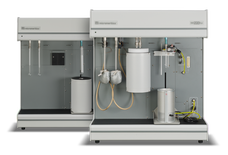
High resolution surface area and porosity analysis. Anytime upgrade options. Physisorption and chemisorption like you've never seen before.